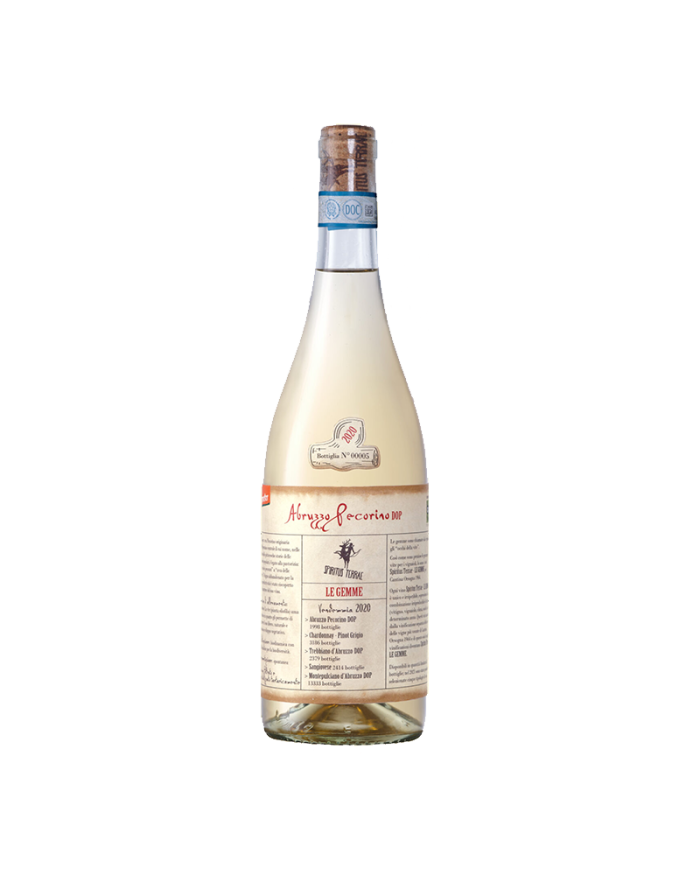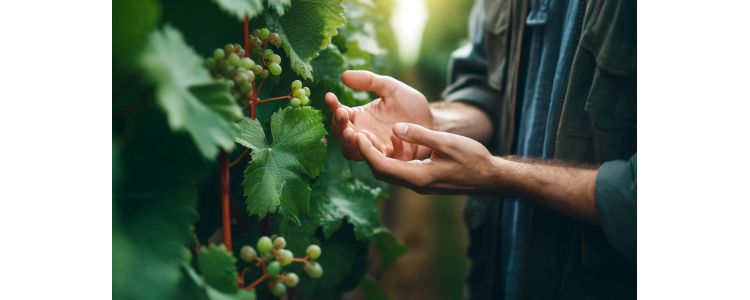Grape variety 100% Pecorino Origin of the Grape Pecorino is a native white grape variety of the Marches and Abruzzo. The first documentary source on the origin of the vine dates back to 1526 and is contained in the Statutes of Norcia (PG) where there is a reference to the «vineyards of pecurino». In 1876 the result of the census on the vines of the Ministry of Agriculture indicates the presence of the pecorino vine in the provinces of Pesaro, Ancona, Macerata and Teramo. This vine, which spread before phylloxera, was gradually abandoned during the 1900s to make room for more productive varieties such as Trebbiano. After years of oblivion, during which Pecorino risked extinction, the winemakers of the Marches and Abruzzo began to cultivate it and vinify it in purity. Possible origins of the name: Grape of the “pecorari”: name of a grape reputed to be of little value, suitable for humble people such as “i pastori” (derogatory term); The “sparkling pecorino” cheese: the wine of this grape refermented (malic acid) with the first heat of spring, presenting itself as effervescent, “lively” or “sparkling”. Similarly, cheese made from sheep's milk was, and is, marked by a vivacity of flavour. Here emerges the similarity and the ancient synonymy of the terms "spicy" (cheese) and "sparkling" (wine); "Gourmet sheep": the departure for the transhumance (the seasonal migration of the flocks with their shepherds) coincided with the ripening period of this grape and the sheep were attracted by the sweet bunches with quarrels between shepherds and farmers because of the sheep that damaged the vineyards; The "elongated" shape of the bunches would seem to recall the shape of a sheep's head. Pecorino is a rocky wine, with a remarkable structure, capable of accumulating sugar-alcohol but well supported by an acidic shoulder. Sharp but never rude, it does not have subtle finesse but has a lot of pulp that has earned it the reputation of "red wine dressed in white". Training form Tendone or in the local dialect “la capanne”. Traditional expanded cultivation of the area which is characterized by a low density of plants per hectare ( 1.100-1.600 ) capable of supporting the natural harmony of the vegetative development of the vine. In the "huts" the harvesting and pruning are exclusively manual, closely linked to the winemaker and the small peasant property. Soil and Altitude Deep clayey soils with calcareous veins. Vineyards cultivated at 400-500 m slm level Type of Biodynamic Agricultural Management with DEMETER certification. Biodynamic cultivation is important for the microbiological life of the soil which is fundamental in the spontaneous fermentation of biodynamic wine. In conventional agriculture, the use of fungicides weakens yeast populations and makes spontaneous fermentation very difficult. Biodynamics restores the place of origin to the wine, defined by the French as "Terroir" (territoriality).
Vinification SPONTANEOUS FERMENTATION For millennia, fermentations have taken place spontaneously triggered by yeasts present in nature, the so-called indigenous or autochthonous or wild yeasts, which differ from area to area and are capable of transmitting the unique characteristics of the place and the vintage to the wine.
WHAT KILLED SPONTANEOUS FERMENTATION? Spontaneous fermentations, linked to wild yeasts, got into trouble with the diffusion of pesticides, chemical fertilizers and herbicides in the early 60s which annihilated the microbiological life of our vineyards, forcing us to resort to selected yeasts for starting the fermentation. Only with careful and clean agriculture, the result of a synergistic relationship with nature, it will be possible to bring healthy and microbiologically "alive" grapes to the cellar, therefore capable of facing a spontaneous fermentation and a winemaking process free of forcing and constraints, for a true expression of the terroir. Fundamental for the success of a spontaneous fermentation is also that the winemaking technique is respectful of microbial life: the addition of sulphites on the grapes or in the musts kills the grape microflora (yeasts) and compromises the fermentation. This is the reason why spontaneous fermentation can only be carried out without the addition of sulphites while conventionally the use of sulphite-tolerant industrial yeasts allows for fermentation also with the addition of sulphites.
TERROIR AND MICROBIAL BIOGEOGRAPHY Biodynamic wines link their complexity to spontaneous fermentation where in the first phase of fermentation the apiculated yeasts impart to the wine the fingerprint of the microbial terroir through unique organoleptic profiles. In conventional fermentation, the apiculated yeasts are not allowed to express themselves as they are eliminated with the sulphites and with the strong colonization of the added industrial yeasts. NATURAL TARTARIC STABILIZATION Finding small crystals (tartrates) in the bottle means that "the wine felt cold" and that it released harmless natural precipitations. In biodynamic wine, physical (refrigeration) and chemical (addition of carboxy-methyl-cellulose, meta-tartaric acid, gum arabic and other) treatments are not allowed and only winter cold is used as an element of tartaric stabilization. The conventional tartaric stabilization technique provides that the wine must be brought from room temperature to around -6/-7 °C before being bottled and kept at this temperature for a few days (6-7). The conventional tartaric stabilization technique, especially in the summer period, leads to a considerable energy consumption. A real pity this enormous energy consumption to avoid the presence of a few milligrams of harmless tartrate crystals.
LIMITS OF SULFITES Limit of biodynamic wine Demeter = white wine max 90 mg/lt FILTRATION Sterile filtration is not permitted. AGING Cement tanks and bottle. sensory characteristics
ORGANOLEPTIC PROFILE Colour: brilliant straw yellow with golden reflections. Bouquet: decisive and deep, with hints of orange, elderberry, spices and woody citrus notes, hay, dried flowers and anise. Taste: mineral, harmonious, very persistent. GASTRONOMIC COMBINATION Elaborated first courses, white meats, fish and shellfish dishes. SERVE AT 10-12°C
Data sheet
| Alcoholic strength | 14.0% |
|---|---|
| Format | 750 ml |
| Name | Terre di Chieti |
| Disciplinary | I.G.T. |
| Grape variety | Pecorino |
| Region | Abruzzo |






